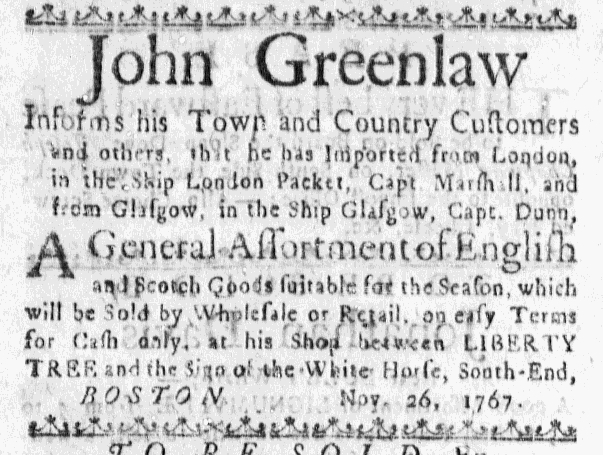What was advertised in a colonial American newspaper 250 years ago today?

“At his Shop between LIBERTY TREE and the Sign of the White Horse.”
During the era of the American Revolution, advertisers had a variety of means for identifying locations in cities and towns. The largest ports began imposing order on urban environments by assigning standardized street numbers at the very end of the eighteenth century. Until then, colonists relied on a variety of landmarks, shop signs, and other devices for giving directions. In the December 4, 1767, edition of the Massachusetts Gazette and its supplement, for instance, Thomas Hickling invited potential customers to visit “his Shop at the Corner of Black Horse Lane, leading to Charlestown Ferry.” Samuel Hughes sold maritime supplies “At his Store next to Capt. Chever’s in King-Street, BOSTON.” Jonathan Davis indicated that he sold his wares “Near BULL’s Wharf.” Despite the varying levels of specificity, each advertiser assumed he provided enough information for potential customers to find his place of business.
In giving directions to his shop, John Greenlaw not only named local landmarks but also invoked political attitudes expressed widely throughout the colony in recent months. He informed customers that he ran a shop “between LIBERTY TREE and the Sign of the White Horse, South-End, BOSTON.” The Townshend Act went into effect less than a week before Greenlaw first inserted his advertisement in the Massachusetts Gazette in the November 26 issue. In the preceding weeks, all of the Boston newspapers devoted significant coverage to the new duties on imported goods and the local response, including resolutions calling for new non-importation agreements passed at the town meeting at the end of October. Even as he sold “A General Assortment of English and Scotch Goods” imported before the Townshend Act went into effect, Greenlaw associated his business with the Liberty Tree, a symbol of colonial resistance to Parliament.
Colonists like Greenlaw used advertisements to express their political views in the public prints. In the time between the repeal of the Stamp Act and the imposition of the Townshend Act, only John Gore, Jr., consistently incorporated the Liberty Tree into his advertisements. Now that colonists once again experienced Parliamentary overreach, other advertisers in Boston expressed political sentiments by adopting the Liberty Tree as a significant landmark for giving directions to readers. In addition to Greenlaw, another advertiser listed a “handsome Dwelling House” to rent “at the South-End of Boston, near LIBERTY TREE” in the December 4 issue. In an era when advertisers creatively devised a variety of methods for giving directions in print, Greenlaw, Gore, and others could have chosen other landmarks or devices to describe their locations. In selecting the Liberty Tree to include in their advertisements, they communicated more than just where potential customers could find them.
